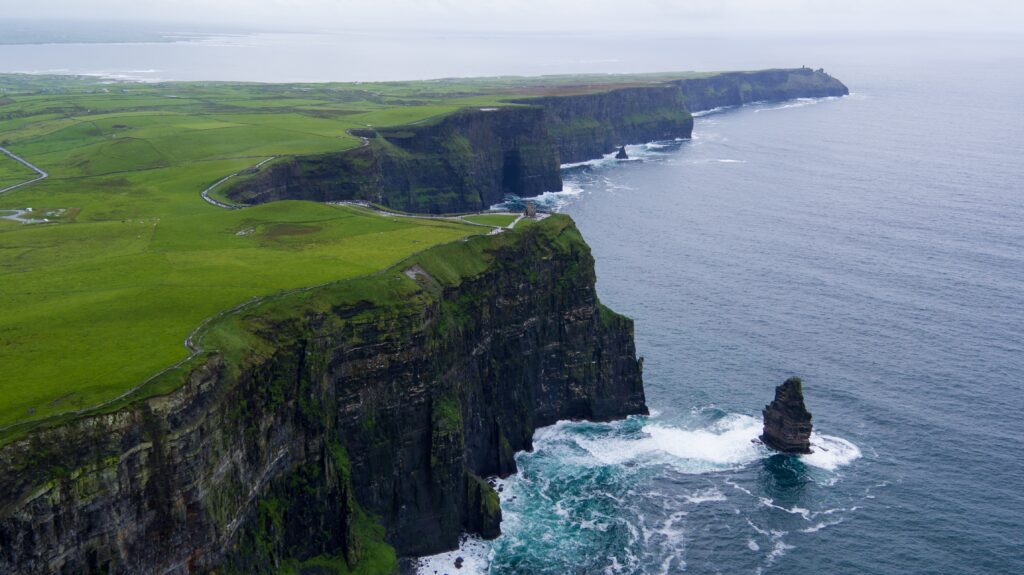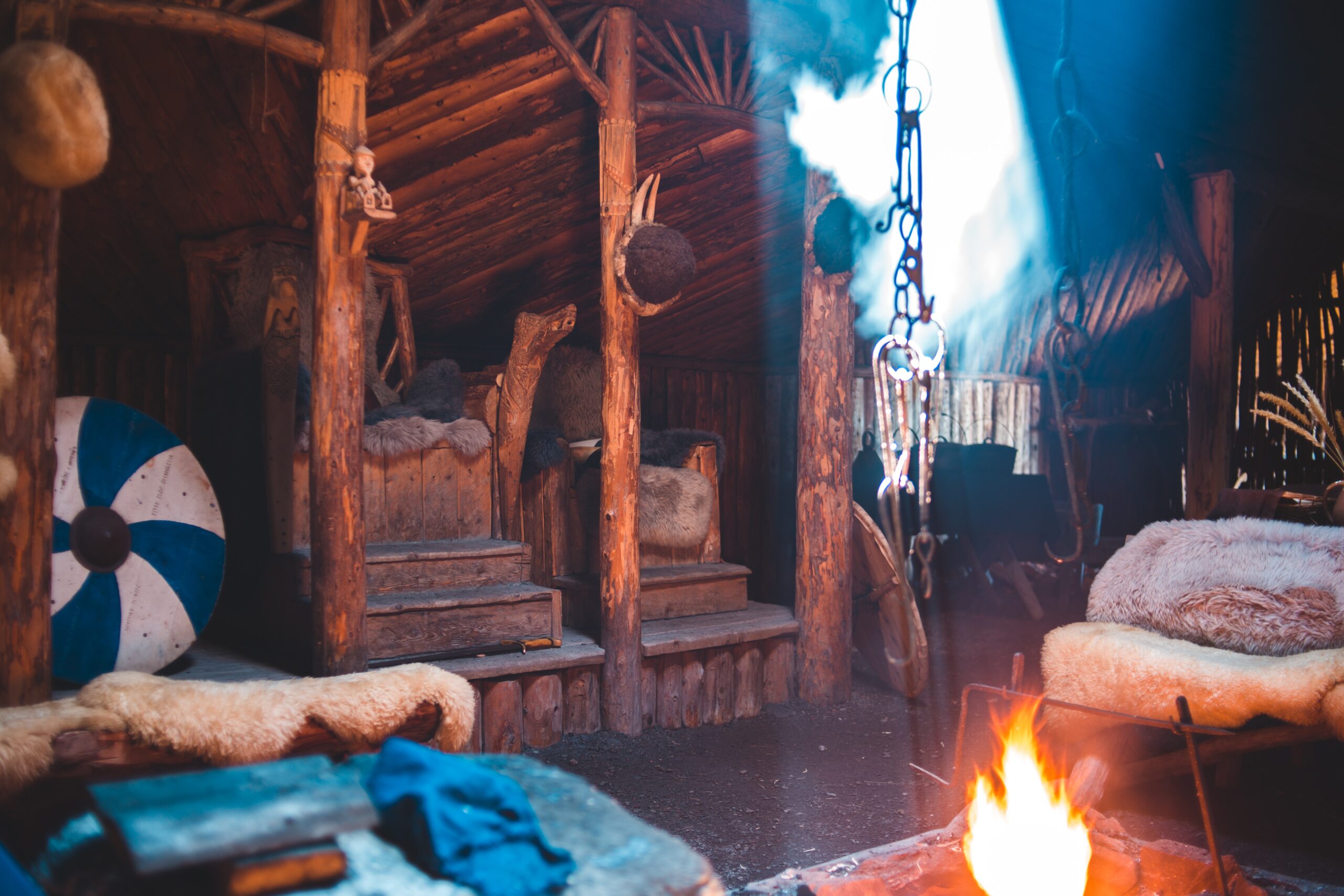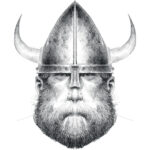Þat mælti mín móðir,
at mér skyldi kaupa
fley ok fagrar árar,
fara á brott með víkingum,
standa upp í stafni,
stýra dýrum knerri,
halda svá til hafnar
hǫggva mann ok annan,
hǫggva mann ok annan.
English:
My mother told me
Someday I would buy (buy)
Galleys with good oars
Sails to distant shores
Stand up on the prow
Noble barque I steer
(Steady) Steady course to the haven
Hew many foe-men
Hew many foe-men
– Egils saga, Lausavísur, ch. 40. (Scudder & Óskarsdóttir, 2002)
The song My mother told me, also known as Þat mælti mín móðir in its ninth-century old Norse form, is probably most recognizable through the popular show Vikings. However, as an archaeologist, this song ignites something inside of this author’s never-ending thought experiments on this population which existed during the Iron Age. The Vikings were likely faced with several economic, political, and social pressures in Norway during the Viking Age, and started to venture abroad for various reasons. As the song goes: my mother told me, someday I would buy galleys with good oars, sails to distant shores. It was not only the spark of excitement for the new, but also the pressure from the homeland that led the Vikings to venture to distant shores. This is very important to remember! There are many examples that fit into the understanding of this hymn, and the example below serves as a great reminder of the reality to some of the Norse Viking Age people.
From conquest to power in Ireland
Local, political, and economical power pressures forced some of the Norse population to migrate. The Viking migrations to Dublin highlight a certain thirst for power and fame, as they were, to a higher degree, unattainable in their homeland. If they wanted power and fame, they needed to find it another place than their homeland. Which some did.
My mother told me
Someday I would buy (buy)
Galleys with good oars
Sails to distant shores
The Viking raids came as a shock to the Irish population, and when the Vikings overwintered in Dublin in 841-842 AD, they had come to stay. For a while, at least. Dublin arguably became the first-ever documented urban community constructed in Ireland. Dublin was quickly recognized as the most powerful Scandinavian Viking kingdom and became a central place for trade and international connections. As it quickly as it became powerful, Viking Dublin sought to dominate all Viking activity in the country. Which they succeeded in doing.
The Vikings who came to Ireland, arrived to a country where the local dynasties were in constant battle with each other. The Vikings played their cards intelligently and held an important position in the struggles between the Irish dynasties. In the battle of Killiner in 868 AD, the king of Tara, Aed Finnliath (r. 862-79) stood against the kings of Brega and Lenister. In this battle, roughly three hundred Vikings took part in this battle and were led by Carlus, son of Amlaíb of Dublin. The outcome of the battle, in this sense, is irrelevant. However, strategic interventions by the Vikings, such as getting hired as manpower for the Irish’s own battle against themselves, created great opportunities for the Viking population. And they were very good at strategic fighting. And by doing this they could form alliances with said kings or lords, which further contributed to their conquest for power. They sought everything on their way to gain this power. This included both land, resources, wealth, and dynastic power. And it worked.

A common enemy
As quickly as Dublin became a dominant power center, the opposing Irish society suddenly had a common enemy to eliminate. If that was not enough, the never-ending power struggle between the Vikings themselves created distress in Dublin. After the death of king Ímar (Ivarr) in AD 873 and king Amlaìb (Ólafr) in 874, at least three rival families fought over the control of Dublin. Amlaìb’s son was murdered in 875, which is only one example of the dynastic assassinations that took place during this period. The struggle of the dynamic power continued in the coming years of 883, 888, and 893, which were periods of further, major, the conflict between the rivaling families. Due to intense resistance from the Irish society and the power struggle between the royal Viking families themselves, the Viking control of Dublin was ebbing fast. The final defeat for the Dublin Vikings came in 902 when the kingdom of Brega from the north and Lenister to the south joined forces to defeat their common enemy.
“The pagans were driven from Ireland, i.e. from the fortress of Dublin . . . and they escaped half-dead after they had been wounded and broken,” – Annalist records (Corráin, 2001, s. 21-22).
The great sea-fleet of pagans
Stand up on the prow
Noble barque I steer
(Steady) Steady course to the haven
Hew many foe-men
Hew many foe-men
The sudden appearance of a ‘‘great sea-fleet of pagans’’ at Waterford Harbour in 914 marks the second wave Viking Age in Ireland. Things were not going to get any easier from here for the Irish clans. Never before had the Vikings behaved so violently and aggressively, and the number of leaders and elites killed during the Battle of Islandbridge in 914 had never occurred either. This clearly stunned the Irish population, as the Vikings claimed control over Dublin yet again.
The confusing number of men named Amlaìb, makes these events even harder to understand. Hold on tight! During the second Viking Age in Ireland, Amlaìb was the Viking king of Dublin and evidently the foremost figure in Viking society in the British Isles and Ireland. He was described as: ‘’the pagan Anlaf (Amlaib), king of the Irish and many islands …’’. At the end of his life, Amlaíb was king of Dublin, half of the kingdom of England, and probably some part of Scotland. He died in 941 and was succeeded by his kinsman, Amlaìb Cuarán. When he was in York to regain his power, the King of Tara, Congalach (r. 944-56) allied with the king of Lenister and ambushed Dublin with newfound brutality:
The destruction brought upon it was this: its houses, house-enclosures, its ships, and its other structures were burned; its women, boys, and common folk were enslaved; its men and its warriors were killed; it was altogether destroyed, from four persons to one, by killing and drowning, burning and capture, apart from a small number that fled in a few ships and reached Dalkey (Corráin, 2001, p. 24).
The final defeat of Amlaìb Cuarán in 980 AD marks the end of the power struggle and power-center of the Vikings in Dublin. However, the Viking control of Dublin was defeated, succeeded, and re-taken by the Irish many times before the gradual change and end of the Irish Viking Age. Despite their expulsion, the Vikings had imprinted many things onto Irish society. They, now, shared a common culture. A political, literary, and artistic that has set its mark on the Irish Viking material from this period.
My mother told me
My mother told me may hold great insight into the Norse society and marks a time where they had to fight for their place in society, even if it was in Norway or overseas. The complexity of the Norse migrations and settlements in Dublin and the rest of Ireland portrays the importance this song holds to the reality of the Norsemen’s lives and how it may have affected them. In many ways, they were successful. And sometimes, not as much. No matter how many times we twist and turn it: the Vikings were very successful in their quest to power and fame, and it lasted for quite a while before they were defeated. This is at least the case in Dublin.
The song My mother told me may also signify and amplify a modern view of the Vikings. It has been nicely fitted into the popular show Vikings and has from there becoming an illuminating factor of identifying and understanding the Viking Age in the modern perspective, aside from the historical and archaeological aspects. Archaeology and history have one way of portraying the Viking Age, and the popular media has another. Either way, the hymn My mother told me is still highly relevant in understanding the Viking Age through a modern perspective, and at the same time a glimpse of a possible past. As far as I see it, it portrays a different way of understanding the Viking Age entirely.
Text: Martine Kaspersen, 2021. Copyright 2021 Scandinavian Archaeology
Cover photo: Erik Mclean from Pexels
Photo: Kelly Lacy from Pexels
Further reading:
Corráin, D. Ó.
The Vikings in Ireland. 2001. In: Larsen, A. C (eds.). The Vikings in Ireland. The Various authors & The Viking Ship Museum in Roskilde: Denmark.
Eldjàrn, K.
1984. Graves and grave goods: survey and evaluation. In: Fenton, A & Pàlsson (eds.) The Northern and Western Isles in the Viking World: Survival, Continuity and Change. Donald: Edinburgh. pp. 2-11.
Floinn, R. Ó.
2020. Personal beliefs in Hiberno-Norse Dublin. In: Pedersen, A & Sindbæk, S. M (eds.). Viking Encounters. Proceedings of the Eighteenth Viking Congress. Denmark: Aarhus University Press.
1998. The Archaeology of the Early Viking Age in Ireland. In: Clarke, H. B., Mhaonaigh, M. N. & Floinn, R. Ó. (eds.) Ireland and Scandinavia in the Early Viking Age. Four Courts Press: Dublin.
Glørstad, Z. T.
2014. Homeland – Strange Land – New Land. Material and Theoretical Aspects of Defining Norse Identity in the Viking Age. In: Celtic-Norse Relationships in the Irish Sea in the Middle Ages 800-1200. Sigurdsson J.V. & Bolton, T. (eds.). Brill:Leiden & Boston.
Harrison, S. H. & Floinn, R.
2014. Viking Graves and Grave-Goods in Ireland. In: Medieval Dublin Excavations 1962-81. National Museum of Ireland: Ireland.
Heen-Petersen, A.
2019. The Earliest Wave of of Viking Activity? The Norwegian Evidence Revisited. In: European Journal of Archaeology 22 (4). pp. 523-541.
Hedenstierna-Jonson, C.
2020. Warrior Identities in Viking-Age Scandinavia. In: Aannestad, H. L., Pedersen, U., Moen, M., Naumann, E., & Berg, H. L. (eds.). Vikings Across Boundaries: Viking-Age Transformations–Volume II. Routledge.
Lydon, J.
1998. The Making of Ireland. From ancient times to the present. London & New York: Routledge.
O’Brien, E.
1993. Viking burials at Kilmainham and Islandbridge. In: Batey, C. E., Jesch, J & Morris, C. D. (eds.) The Viking Age in Caithness, Orkney and the North Atlantic: Select Papers from the Proceedings of the Eleventh Viking Congress, Thurso, Kirkwall. 22 August – 1 September 1989.
Scudder, B & Óskarsdóttir, S.
2002. Egil’s Saga. London: Penguin Books.
Skre, D.
2014. From Kaupang and Avaldsnes to the Irish Sea. In: Celrics, kings and Vikings. Essays on medieval Ireland in honour of Donnachdh Ó Corráin. Four Courts Press. pp. 237-246.
About the author

Martine Kaspersen
Iron Age Scandinavian archaeologist with a bachelor specialized in Viking Age identity from the previous Viking Age settlement site at the Broch of Birsay and a master specialized in identity during the Early Viking Age in migrating societies in Orkney and Dublin based on grave goods from burials from said places. Exchange studies during the bachelor degree to University of the Highlands and Islands in Kirkwall, Orkney.
In my master thesis, I analyzed a total of 124 burials from Orkney and Dublin, where I attempted to distinguish different expressions of identity. This aimed to create a different perspective on the migrating societies and that they had several differences in their settlements, even though they originated from the same homeland. The main expressions of identity were gender, warrior, and religious identity.
As a writer for Scandinavian Archaeology, I am responsible for writing some of the articles presented, which is a job I am very devoted to.



Highly interesting and insightful read, Martine! Thank you!
Hi,
We are glad you enjoyed the article!
All the best, team Scandinavian Archaeology